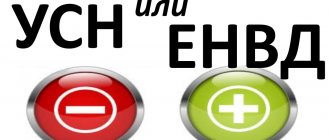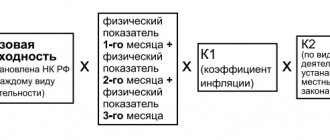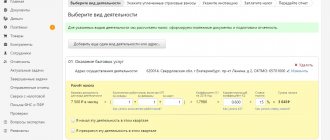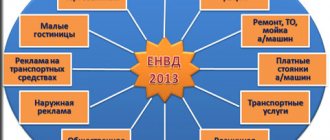Legal entities and entrepreneurs pay various fees and charges depending on the taxation scheme. One of the common ones is the tax on imputed income, or UTII in Moscow. And after the recent news, which discussed whether there is UTII in Moscow now and whether there will be one in 2021, companies are at a loss: is it worth continuing to work on the “imputed” basis?
On September 26, 2012, Moscow government authorities signed Law No. 45 on a scheme for imposing fees as imputed profits for a certain type of activity. Decree No. 45 spells out the provisions on which areas of Moscow the decree applies to, the values of the formula indicators for calculating the amount of UTII in the city of Moscow for 2020, and collection tariffs.
The use of “imputation” exempts companies from paying the main fees:
- at a profit;
- VAT;
- on the property of organizations.
UTII in 2021 for individual entrepreneurs in the city of Moscow does not pay a fee:
- on the property of individuals;
- Personal income tax.
The single fee is paid once every three months, or quarter, before the 25th day of the month following the reporting month. Before depositing tax funds, an entrepreneur or legal entity fills out and submits the corresponding declaration by the 20th of the reporting period through the online service of the Federal Tax Service, State Services, or sends it by Russian post or independently. An authorized person has the right to submit the declaration, but only with a certified power of attorney.
Conditions for using UTII in Moscow
Companies have the right to apply “imputation” in accordance with Chapter 26.3 of the Tax Code of the Russian Federation, which contains detailed information about the levy on expected profits. Analyzing the articles, we obtain a number of requirements for the use of this aid to navigation:
- UTII is used equally with other taxation schemes.
- When calculating and paying tax funds, companies must comply with the rules specified in Art. 346.32 Tax Code of the Russian Federation.
- Companies need to work with cash register systems in accordance with the legislation of the Russian Federation in compliance with changes, using cash and non-cash payments.
- If a company operates under several OKVED codes, which are subject to imputation, then separate records are kept in accordance with clause 6 of Art. 346.26 Tax Code of the Russian Federation.
- When working with OKVED, which are taxed under different SNOs, accounting for property, business and other transactions is kept separately.
According to the latest news, “imputation” will be abolished from January 1, 2021, so tax officials recommend that organizations and legal entities gradually switch to the simplified tax system or PSN.
About the validity period of the UTII system
According to Law No. 178-FZ, adopted on June 2, 2016, the validity of UTII was extended from the end of 2021 to 2021 inclusive. The reason for the extension was the unwillingness of many entrepreneurs to switch to the patent system, developed as an alternative.
Thus, the possibility of using UTII for an additional 2 years allows individual entrepreneurs to apply this system in practice, if their type of activity allows it.
Also see “Starting from 2021, the gradual abolition of UTII will begin in Russia: who will this affect?”
Read also
14.12.2017
Legislative changes
In 2011, the Moscow government considered a bill to abolish SNO, which implies the payment of a tax on imputed profit, since 2014, but the provision never came into force. In 2021, the State Duma raised this issue again, and it was decided to start in 2021, but the deputies decided to postpone the procedure until 2021, while the UTII is in effect in Moscow.
At the federal level, including in Moscow, the conditions for applying “imputation” have changed:
- use of online cash register. The legislation of the Russian Federation has changed the provisions: enterprises on the “imputation” are allowed to use cash register machines without fail from July 1, 2021. The suspension applies to companies that:
- provide various services to residents subject to the issuance of a SSO (strict reporting form) to the client. The deferment does not apply to entrepreneurs who own catering companies with employees who work under the GPA;
engage in vehicle repair, advertising, own veterinary clinics, car washes, subject to the issuance of a sales receipt to the client.
But, according to paragraph 2 of Art. 2 Federal Law No. 54 of May 22, 2003 (as amended on July 3, 2018), some types of OKVED are allowed not to use cash registers at all. If the company:
- manufactures metal fittings and haberdashery;
- repairs and paints shoes;
- sells excise-free goods that are not subject to labeling, on sale (carts, street tents),
then it is not necessary to pay a fee on approximate profits from the provision of services or trade.
New form of declaration for UTII
The Federal Tax Service, by its order dated October 19, 2016 No. ММВ-7-3/ [email protected], changed the form of the current tax return for UTII. The Ministry of Justice did not have time to quickly register the order, so it did not have time to come into force two months before January 1, 2021. As a result, taxpayers may report for 2021 using the old form. They will have to submit a new declaration for the first quarter of 2021. The main changes, however, were made not to the form itself, but to the annexes to it. This is mainly due to new codes and other amendments to tax legislation. In particular, the following changes were made to the report form:
- The barcodes of the fields in section 3 of Appendix No. 1 to the tax return have changed.
- The name of the element “The amount of insurance contributions paid by an individual entrepreneur to the Pension Fund of the Russian Federation and the Federal Compulsory Medical Insurance Fund in a fixed amount” was replaced by the name “The amount of insurance contributions paid by an individual entrepreneur in a fixed amount for compulsory pension insurance and compulsory medical insurance” in Table 4.14 of Appendix No. 2.
- The names of the lines and the calculation procedure in Appendix No. 3 have changed.
Types of activities for UTII in Moscow
According to paragraph 2 of Art. 346.26 of the Tax Code of the Russian Federation Federal Law No. 117 of 08/05/2000 (as amended on 11/27/2018), UTII in Moscow in 2021 has the right to apply to enterprises that work in a certain field. So, to work on UTII in Moscow in 2021, the company chooses the following types of activities:
- retail trade;
- real estate, repair services;
- passenger road transport, parking lots.
Thus, in order to work on the imputation system, companies need to correctly determine OKVED in order to apply the scheme legally.
The Order of the Government of the Russian Federation No. 2496-r dated November 24, 2016 details lists containing OKVED codes that relate to household services and related products.
REDUCTION OF UTII FOR FIXED CONTRIBUTIONS
Let us remind you that from 01/01/2017, an individual entrepreneur who has employees has the right to reduce UTII by the amount of fixed contributions paid to the funds within 50% of the calculated UTII.
Until 2021, individual entrepreneurs on UTII using hired labor reduced UTII only by contributions paid for employees within 50% of the calculated UTII; UTII was not reduced by contributions paid for the individual entrepreneur himself.
In 2021, the rule for reducing UTII for insurance premiums will continue to apply.
VAT FOR UTII IN 2018-2019
Law No. 335-FZ of November 27, 2021 determines that entrepreneurs using UTII can deduct value added tax on the following grounds:
- Art. 161 of the Tax Code of the Russian Federation (tax agents);
- Art. 174.1 of the Tax Code of the Russian Federation (simple partnership, joint venture, investment partnership, trust, concession).
Features of the transition to UTII
Firms using taxation schemes OSNO, simplified tax system, PSN, sometimes plan to switch to “imputation”, since this fee involves a smaller number of duties. But UTII is a tax that applies to certain types of work and is not suitable for all companies. But if an individual entrepreneur or legal entity works on OKVED, suitable for using “imputation”, then under certain conditions the Federal Tax Service will refuse the organization to use this SNO.
An individual entrepreneur does not have the right to switch to “imputation” if:
- the company employs more than 100 people;
- leases premises for trade, which are located in a stationary area without trading floors, as well as catering outlets without seats;
- leases land property to stationary and non-stationary networks for trade or public catering.
The transition to imputation for legal entities and individuals is different from each other. Legal entities that meet the following criteria are not entitled to transfer the fee on approximate profits:
- share ownership of other companies is more than 25%;
- the company employs more than 100 people;
- rents out the same types of premises and property as individual entrepreneurs;
- rents out parking lots and gas stations.
KBK for tax payment
When allocating funds to the budget for insurance and taxes for individual entrepreneurs in 2019 on UTII without employees, it is important to indicate the correct BCC. This will help you avoid trouble.
The KBK code for various taxes and contributions already implies a certain tax, fine or penalty. Depending on the circumstances of commercial activity, the codes may be as follows:
- without employees - regardless of the number of employees, the tax is calculated based on the area of the premises. To pay the tax, use KBK - 182 1 0500 110;
- code for payment of penalties – 182 1 0500 110;
- code for paying fines – 182 1 0500 110.
Calculation of UTII in Moscow
The amount of the fee for imputed profit is calculated using a standard formula, which is approved by the legislation of the Russian Federation. The total amount of the duty consists of the tax base, the basic profitability of the organization for the reporting period, and the collection rate. If an entrepreneur or legal entity plans to add the resulting figure to the budget, then he has the right to deduct insurance premiums from the resulting result.
Standard formula for calculating the total amount of imputation duty:
(DB x FP x K1 x K2) x Nst, where
- BD - basic profitability;
- FP - physical indicator;
- K1 and K2 - indicators for which the database is indexed;
- Nst - collection tariff.
Physical indicators, basic profitability, K1 are prescribed in Art. 346.29 Tax Code of the Russian Federation. The second coefficient should be obtained from the local Federal Tax Service employees.
The formula for calculating the amount of the fee, provided that an individual entrepreneur or legal entity operates for an incomplete reporting period, is indicated in paragraph. 3 clause 10 art. 346.29 Tax Code of the Russian Federation:
(DB x FP): CD x CD1, where
- BD - the basic profitability of the company for the reporting period;
- FP - physical indicator;
- KD - number of days in the current month;
- KD1 - the number of days in which the company actually worked.
According to paragraph 7 of Art. 346.29 of the Tax Code of the Russian Federation, K2 is established at the municipal level by the authorities of the city of Moscow. The correction indicator is rounded to the third decimal place, just like K1.
Basic profitability for UTII by activity codes in 2021
| Codes | Types of business activities | Taxpayers | Physical indicators | Basic income per month, rub. |
| 01 | Provision of household services | Entrepreneurs and organizations | Number of employees, including entrepreneur | 7500 |
| 02 | Provision of veterinary services | Entrepreneurs and organizations | Number of employees, including entrepreneur | 7500 |
| 03 | Providing repair, maintenance and washing services for motor vehicles | Entrepreneurs and organizations | Number of employees, including entrepreneur | 12 000 |
| 04 | Provision of services for the provision of temporary possession (for use) of parking spaces for motor vehicles, as well as for the storage of motor vehicles in paid parking lots | Entrepreneurs and organizations | Parking area (sq. m) | 50 |
| 05 | Provision of motor transport services for the transportation of goods | Entrepreneurs and organizations | Number of vehicles used to transport goods | 6000 |
| 06 | Provision of motor transport services for the transportation of passengers | Entrepreneurs and organizations | Number of seats | 1500 |
| 07 | Retail trade carried out through stationary retail chain facilities with trading floors | Entrepreneurs and organizations | Sales area (sq. m) | 1800 |
| 08 | Retail trade carried out through stationary retail chain facilities that do not have sales floors, as well as through non-stationary retail chain facilities in which the retail space does not exceed 5 square meters. m | Entrepreneurs and organizations | Number of retail places | 9000 |
| 09 | Retail trade carried out through stationary retail chain facilities that do not have sales floors, as well as through non-stationary retail chain facilities with a retail space exceeding 5 square meters. m | Entrepreneurs and organizations | Area of retail space (sq. m) | 1800 |
| 10 | Delivery and distribution retail trade | Entrepreneurs and organizations | Number of employees, including entrepreneur | 4500 |
| 11 | Provision of catering services through catering facilities with customer service halls | Entrepreneurs and organizations | Area of the visitor service hall (sq. m) | 1000 |
| 12 | Provision of catering services through catering facilities that do not have visitor service areas | Entrepreneurs and organizations | Number of employees, including entrepreneur | 4500 |
| 13 | Distribution of outdoor advertising using advertising structures (except for advertising structures with automatic image changes and electronic displays) | Entrepreneurs and organizations | Area intended for applying the image (sq. m) | 3000 |
| 14 | Distribution of outdoor advertising using advertising structures with automatic image changes | Entrepreneurs and organizations | Exposure surface area (sq. m) | 4000 |
| 15 | Distribution of outdoor advertising through electronic signboards | Entrepreneurs and organizations | Light emitting surface area (sq.m) | 5000 |
| 16 | Advertising using external and internal surfaces of vehicles | Entrepreneurs and organizations | Number of vehicles used for advertising | 10 000 |
| 17 | Provision of temporary accommodation and accommodation services | Entrepreneurs and organizations | Total area of premises for temporary accommodation and living (sq. m) | 1000 |
| 18 | Provision of services for the transfer for temporary possession and (or) use of retail spaces located in facilities of a stationary retail chain that do not have trading floors, facilities of a non-stationary retail chain, as well as catering facilities that do not have customer service halls, if the area of each of them does not exceed 5 sq. m | Entrepreneurs and organizations | Number of retail places, non-stationary retail chain facilities, catering establishments transferred for temporary possession and (or) use | 6000 |
| 19 | Provision of services for the transfer for temporary possession and (or) use of retail spaces located in facilities of a stationary retail chain that do not have trading floors, facilities of a non-stationary retail chain, as well as catering facilities that do not have customer service halls, if the area of each of them exceeds 5 sq. m | Entrepreneurs and organizations | Area of retail outlets, non-stationary retail chain facilities, catering establishments transferred for temporary possession and (or) use (sq. m) | 1200 |
| 20 | Provision of services for the transfer for temporary possession and (or) use of land plots with an area not exceeding 10 square meters. m, for the placement of stationary and non-stationary retail chain facilities, as well as catering organizations | Entrepreneurs and organizations | Number of land plots transferred for temporary possession and (or) use | 10 000 |
| 21 | Provision of services for the transfer for temporary possession and (or) use of land plots with an area exceeding 10 square meters. m, for the placement of stationary and non-stationary retail chain facilities, as well as catering organizations | Entrepreneurs and organizations | Area of land plots transferred for temporary possession and (or) use (sq. m) | 1000 |
| 22 | Sales of goods using vending machines | Entrepreneurs and organizations | Number of vending machines | 4500 |
You indicate the code for the type of business activity on line 010 of section 2 of the UTII tax return. The types of activities subject to UTII are listed in paragraph 2 of Article 346.26 of the Tax Code of the Russian Federation. The codes are indicated in Appendix 5 to the order of the Federal Tax Service of Russia dated July 4, 2014 No. ММВ-7-3/353. The basic profitability for all types of business is established by paragraph 3 of Article 346.29 of the Tax Code of the Russian Federation.
Unlike K1, which is set at the federal level, K2 is allowed to be set by local authorities, but, as a rule, in most regions it is equal to 1, i.e. does not affect the amount of UTII.
The definition of K2 is presented in Art. 346.27 of the Tax Code of the Russian Federation (hereinafter referred to as the Tax Code of the Russian Federation) is an adjusting coefficient of basic profitability, which includes taking into account various features of doing business. K2 depends on the list of works provided, services or goods sold, seasonality and operating hours, the amount of income received, etc.
In some regions, K2 must be calculated using a formula approved by local authorities.
UTII rates in Moscow
According to Art. 346.31 of the Tax Code of the Russian Federation, “imputation is subject to a standard rate of 15%, but the amount of the fee calculated taking into account this figure varies depending on the type of activity of the company. Thus, each OKVED is subject to an increasing or decreasing coefficient K1 and K2. The first is legalized at the federal level, the second is regulated by local authorities.
Despite the fact that it has been postponed, individual entrepreneurs and legal entities are recommended to take a closer look at a more suitable SNO to make the transition easier. A single fee for estimated profits in Moscow is in effect now and will remain until December 31, 2020 inclusive.
Changes for 2021 in the formula for calculating UTII
The formula for calculating UTII includes not only the basic profitability, but also a physical indicator (number of employees, area in square meters, number of transport units, etc.). In addition, the final tax amount is affected by two coefficients - K1 and K2.
The K1 coefficient is established annually by order of the Ministry of Economic Development of the Russian Federation and is valid throughout the Russian Federation. K1 is called a multiplying factor because it reflects the increase in inflation. For 2019, K1 is set at 1.915. In the previous year it was 1.868, that is, the increase is quite insignificant.
The K2 coefficient is under the control of municipalities. Using K2, local authorities can significantly reduce the imputed tax payable. The K2 fork ranges from 0.005 to 1. Not all administrations of localities approve the reduction factor annually. In some cities, K2 remains at the same level for several years in a row.
Let's look at a specific example to see how much the UTII payable in 2021 will increase compared to 2021.
Individual entrepreneur store without employees in Kurgan with an area of 45 square meters. meters sells clothing and accessories. The Kurgan City Duma established that the K2 coefficient for this type of activity will have a maximum value, that is, “1”.
Moreover, the K2 coefficient has remained unchanged here for several years. This means that the city administration believes that retail trade in clothing is a profitable business, and a reduction in the tax burden is not required. For comparison, for children’s assortment and food stores, K2 is slightly lower (0.7 and 0.8, respectively).
Let's calculate the amount of tax on imputed income using these data using the formula (DB * FP * K1 * K2 * 15%):
- for 2021 – (1800 * 45 * 1.868 * 1) * 15% = 22,696 rubles per month or 68,088 rubles per quarter;
- for 2021 – (1800 * 45 * 1.915 * 1) * 15% = 23,267 rubles per month or 69,801 rubles per quarter.
As you can see, the accrued quarterly tax increased by only 1,713 rubles compared to 2018.
However, this amount can be reduced by insurance premiums that the individual entrepreneur pays for himself. Contributions include not only mandatory payments, but also an additional contribution from the amount of imputed income exceeding 300,000 rubles.
| Period | Mandatory contributions | Imputed income | Additional payment |
| 2018 | 32,385 rubles | 605,232 rubles | 6,052 rubles |
| 2019 | 36,238 rubles | 620,460 rubles | 6,205 rubles |
In total, the individual entrepreneur will pay contributions for himself in 2021 of 38,437 rubles, and in 2019 - 42,443 rubles. We reduce the quarterly tax calculated above by the contributions paid and get the amount of tax payable:
- 58,479 rubles in 2021;
- 59,190 rubles in 2021.
That is, the real tax increase for this individual entrepreneur turned out to be even less - only 711 rubles per quarter.
additional information
An interesting feature of UTII is its ability to simultaneously replace several types of duties from the general taxation system. For example, this duty can replace income tax, value added duty (exports are not taken into account), as well as property tax. An interesting feature of the tax is that when calculating the amount, the average indicators for a particular type of activity are taken into account, and are not linked to the actual income of the taxpayer.
If we talk about the rate, now it is equal to 15% of the total amount. It is important to note that municipal authorities are allowed to reduce the rate from 15% to 7.5%, that is, by half. When reducing the rate, the category to which the taxpayer belongs and the type of his main activity must be taken into account.
General information about UTII
The unified tax on imputed income (UTII) is a taxation system that involves the transfer by an economic entity (individual entrepreneur, LLC, etc.) of a fixed (in relation to physical indicators, the composition of which is regulated by the taxpayer himself) payment to the budget - regardless of the revenue received. Therefore, UTII has the highest demand among businesses with large incomes (especially in retail trade with a sales floor area not exceeding 150 square meters).
Among other advantages of UTII is the ability not to pay VAT in domestic Russian transactions and property tax. The legislator periodically makes changes to regulations governing the application of UTII. Let’s study the list of the most notable innovations in this area of government work in more detail.
Application of online cash register for individual entrepreneurs and LLCs on UTII
From July 1, 2021, it is the turn for LLCs and individual entrepreneurs on UTII providing services to the population, as well as individual entrepreneurs on UTII without employees engaged in retail and catering, to use online cash registers without fail.
Earlier, in 2021, this requirement became mandatory for individual entrepreneurs on UTII, engaged in retail and catering, with employees, as well as LLCs on UTII, engaged in retail and catering - both with and without employees.
Contact our ASC Allat and we will help you choose the optimal cash desk for UTII







